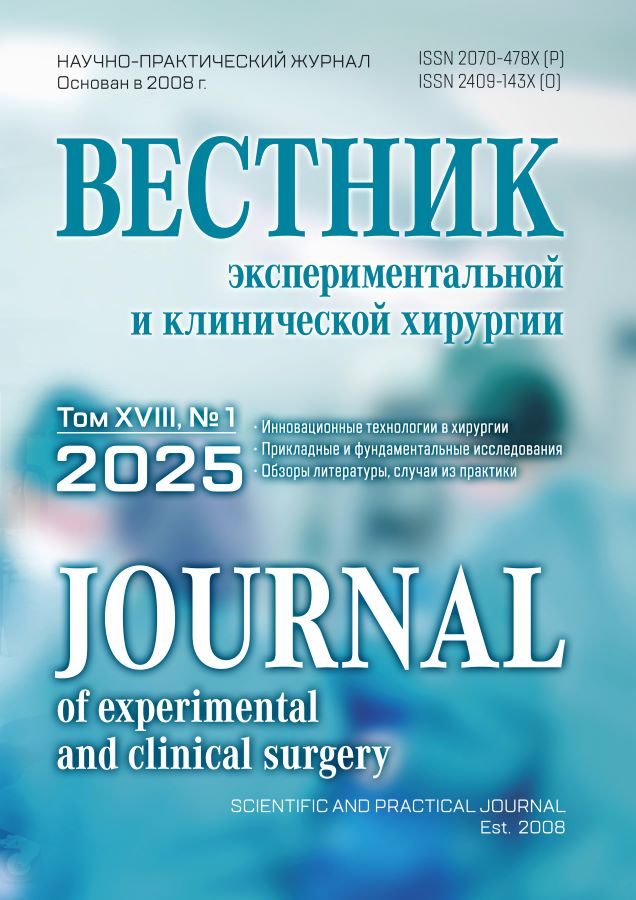Наномедицинские технологии для профилактики бактериальных инфекций и новые возможности в хирургии
- Авторы: Абдулагатов И.М.1, Рагимов Р.М.1, Хамидов М.А.1, Абдуллаева Н.М.1
-
Учреждения:
- Дагестанский государственный медицинский университет
- Выпуск: Том 18, № 1 (2025)
- Страницы: 68-78
- Раздел: Обзор литературы
- URL: https://vestnik-surgery.com/journal/article/view/1820
- DOI: https://doi.org/10.18499/2070-478X-2025-18-1-68-78
- ID: 1820
Цитировать
Полный текст
Аннотация
В данной работе приводится обзор современного состояния проблемы использования достижений нанотехнологий в медицине в России и за рубежом. Рассмотрены возможности и проблемы, связанные с разработкой и внедрением антибактериальных нанопокрытий в индустрию создания медицинских имплантатов, инструментов и устройств медицинского назначения. Обсуждаются методы синтеза и технологии осаждения антибактериальных нанопокрытий на поверхности медицинских имплантов, хирургических изделий и материалов. Приводятся результаты предварительных исследований в области наномедицинских технологий и их различные приложения в хирургии, а также перспективы на будущее. Показана эффективность применения нанотехнологий для придания имплантам антибактериальных свойств с целью предотвращения послеоперационных осложнений, что улучшает качество, срок их службы и надежность. Нанопокрытия на поверхности медицинских имплантов и хирургических материалов позволяют придать им антибактериальные и барьерные свойства, высокую прочность, износостойкость, коррозионную устойчивость, а также необходимые благоприятные физические свойства. На основе анализа опубликованных отечественных и зарубежных работ показано, что нанесение функциональных нанопокрытий на импланты, а также медицинские инструменты, позволяет решить многие проблемы в медицине, в частности, предупреждает попадание токсичных веществ из материалов импланта в организм, образование биопленок на имплантах, инфекционные осложнения, так как некоторые наноплёнки обладают антибактериальными свойствами, увеличивают срок службы и надежность имплантов в силу антикоррозионной активности нанопокрытий из титана и, самое главное, улучшает качество жизни пациентов. В работе описываются фундаментальные основы наномедицинских технологий атомно-слоевого осаждения (АСО) и эффективность их применения для решения широкого класса медицинских проблем, а также конкурентоспособность разрабатываемой отечественной технологии по сравнению с мировыми аналогами.
Ключевые слова
Полный текст
Об авторах
Ильмутдин Магомедович Абдулагатов
Дагестанский государственный медицинский университет
Автор, ответственный за переписку.
Email: ilmutdina@gmail.com
д.т.н., профессор, заведующий лаборатории по фундаментальной наномедицине, главный научный сотрудник
Россия, МахачкалаРазин Мирзекеримович Рагимов
Дагестанский государственный медицинский университет
Email: razinragimov@mail.ru
д.м.н., профессор, заведующий кафедрой нормальной физиологии
Россия, МахачкалаМагомед Ахмедович Хамидов
Дагестанский государственный медицинский университет
Email: khamidov67@mail.ru
д.м.н., профессор, заведующий кафедрой хирургии ФПК ППС
Россия, МахачкалаНаида Муртазалиевна Абдуллаева
Дагестанский государственный медицинский университет
Email: caca1@yandex.ru
к.б.н., доцент кафедры нормальной физиологии
Россия, МахачкалаСписок литературы
- Maynard AD. Nanotechnology: Assessing the risks. Nano Today. 2006; 1(2): 22-33. doi.org/10.1016/s1748-0132(06)70045-7
- Sauer K, Stoodley P, Goeres DM, Hall-Stoodley L, Burmшlle M, Stewart PS, Bjarnsholt T. The biofilm life cycle: Expanding the conceptual model of biofilm formation. Nat. Rev. Microbiol. 2022; 20 (10): 608−620. doi.org/10.1038/s41579-022-00767-0
- Wang X, Ma L, Li Ch, Yang Y-W, Macrocycle-based antibacterial materials. Chem. Mater. 2024; 36:2177−2193. https://doi.org/10:10.1021/acs.chemmater.3c03322
- Тимербулатов Ш. В., Валиев Р. З., Тимербулатов М. В. Нанобиомедицинские технологии в хирургии. Хирургия 2018; 1: 90-98. doi.org/10.1711 6/hirurgia2018190-98
- Liz-Marzan LM, Nel AE, Brinker CJ, Chen Ch, Chen X, Ho D, Hu T, Kataoka K, Kotov N, Parak WJ, Stevens MM. What do we mean when we say nanomedicine? ACS Nano. 2022; 16: 13257−13259. doi.org/10.1021/acsnano.2c08675
- Bhatia SN, Chen X, Dobrovolskaia MA, Lammers T. Cancer Nanomedicine. Nat. Rev. Cancer. 2022; 22: 550−556. doi.org/10.1038/s41568-022-00496-9
- Das PM, Danda G, Cupo A, Parkin WM, Kharche N, Ling X, Huang S, Dresselhaus MS, Meunier V, Drndic S. Supplementary Information Controlled Sculpture of Black Phosphorus Nanoribbons. ACS Nano 2016; 10: 6: 5687-5695. pubs.acs.org/10.1021/acsnano.1c08675.
- Mitchell MJ, Billingsley MM, Haley RM, Wechsler ME, Peppas NA, Langer R. Engineering precision nanoparticles for drug delivery. Nat. Rev. Drug Discovery. 2021; 20: 101−124. doi.org/10.1038/s41573-020-0090-8
- Jia Q, Fu Z, Li Y, Kang Z, Wu Y, Ru Z. Hydrogel loaded with peptide-containing nanocomplexes: Symphonic cooperation of photothermal antimicrobial nanoparticles and pro-healing peptides for the treatment of infected wounds. ACS Appl. Mater. Interfaces. 2024; 16: 13422−13438. doi.org/10.1021/acsami.3c16061
- Makabenta JM, Nabawy A, Li, C-H, Schmidt-Malan S, Patel R, Rotello VM. Nanomaterial-based therapeutics for antibiotic-resistant bacterial infections. Nat. Rev. Microbiol. 2021; 19: 23−36. doi.org/10.1038/s41579-020-0420-1
- Xie M, Gao M, Yun, Y, Malmsten M, Rotello VM, Zboril R, Akhavan, O, Kraskouski A, Amalraj J, Cai X. Antibacterial nanomaterials: mechanisms, impacts on antimicrobial resistance and design principles. Angewandte chemie international editionangew. 2023; 62: e202217345. doi.org/10.1002/anie.202217345
- Wang Y, Yang Y, Shi Y, Song H, Yu C. Antibiotic-free antibacterial strategies enabled by nanomaterials: Progress and Perspectives. Adv. Mater. 2020;32: 1904106. doi.org/10.1002/adma.201904106
- Mei L, Zhu, S, Liu Y, Yin W, Gu, Z, Zhao Y. An overview of the use of nanozymes in antibacterial applications. Chem. Eng. J. 2021; 418: 129431. doi.org/10.1016/j.cej.2021.129431
- Jin L, Cao F, Gao Y, Zhang C, Qian Z, Zhang J, Mao Z. Microenvironment-activated nanozyme-armed bacteriophages efficiently combat bacterial infection. Adv. Mater. 2023; 35: 2301349. doi.org/10.1002/adma.202370213
- Рагимов Р.М., Маммаев С.Н., Хамидов М.А., Абдулагатов И.М., Алкадарский А.С., Абдуллаева Н.М., Абдулагатов А.И., Омаров О.И. Способ улучшения функциональных свойств сетчатых имплантов для пластики грыжевых дефектов. Патент РФ на изобретение № 2756124 C1 29.09.2021. Бюл. № 28. Ссылка активна на 30.03.2024. istina. msu.ru>patents/602352748/
- Максумова А.М., Хидирова С.Т., Магомедов М.З., Цахаева Р.О., Хамидов М.А., Рагимов Р.М., Абдуллаева Н.М., Абдулагатов А.И., Абдулагатов И.М. Способ получения хирургических шовных материалов с антибактериальными свойствами методом атомно-слоевого осаждения. Патент РФ на изобретение № RU 2022 131342А. 25.10.2023. Бюл. № 30.. Ссылка активна на 30.03.2024 istina. msu.ru>patents/602352748/
- Chang Y-N, Zhang M, Xia L, Zhang J, Xing G. The toxic effects and mechanisms of CuO and ZnO nanoparticles. Materials (Basel). 2012; 5: 2850–2871.doi.org/10.3390/ma5122850
- Gupta K, Singh RP, Pandey A., Pandey A. Photocatalytic antibacterial performance of TiO2 and Ag-doped TiO2 against Staphylococcus Aureus, Pseudomonas aeruginosa, Escherichia coli. Beilstein J. Nanotechnol. 2013; 4 (1): 345–351. doi.org/10.3762/bjnano.4.40
- Azam A, Ahmed AS, Oves M, Khan MS, Habib SS, Memic A Antimicrobial activity of metal oxide nanoparticles against Gram-positive and Gram-negative bacteria: a comparative study. Int. J. Nanomed. 2012; 7: 6003–6009. doi.org/10.2147/IJN.S35347
- Puckett SD, Taylor E, Raimondo T, Webster TJ. The relationship between the nanostructure of titanium surfaces and bacterial attachment. Biomaterials. 2010; 31: 706-713. doi.org/10.1016/j.biomaterials.2009.09.081
- Drogui DR, Robert PD. Modified TiO2 for environmental photocatalytic applications: A review. Ind. Eng. Chem. Res. 2013; 52: 3581−3599. doi.org/10.1021/ie303468t
- Ashkarran AA, Aghigh SM, Kavianipour M, Farahani NJ. Visible light photo-and bioactivity of Ag/TiO2 nanocomposite with various silver contents. Curr. Appl. Phys. 2011; 11: 1048-1055. doi.org/10.1016/j.cap.2011.01.042
- Van Grieken R, Marugan J, Pablos C, Furones L, Lуpez A. Comparison between the photocatalytic inactivation of Gram-positive Enterococcus faecalis and Gram-negative Escherichia coli fecal contamination indicator microorganisms. Applied Catalysis B: Environmental Environmental Science, Chemistry. 2010; 100: 212-220. doi.org/10.1016/j.apcatb.2010.07.034
- Araсa J, Herrera Melin JA, Doсa Rodrı́guez JM. TiO2-photocatalysis as a tertiary treatment of naturally treated wastewater. Catal Today. 2002; 76: 279-289. doi.org/10.1016/S0920-5861(02)00226-2
- Iconaru SL, Chapon P, Ph Le Coustumer, Predoi D. Antimicrobial Activity of Thin Solid Films of Silver Doped Hydroxyapatite Prepared by Sol-Gel Method. The Scientific World Journal. 2014. 165351. doi.org/10.1155/2014/165351
- Meng D, Liu X, Xie Y, Du Y, Yang Y, Xiao Ch. Antibacterial Activity of Visible Light-Activated TiO2 Thin Films with Low Level of Fe Doping. Advances in Materials Science and Engineering. 2019; 10: 1155. doi.org/10.1155/2019/5819805
- Mathew S, Ganguly P, Rhatigan S. “Cu-doped TiO2: visible light assisted photocatalytic antimicrobial activity.” Applied Sciences. 2018; 8(11): 2067. doi.org/10.3390/app8112067
- Fujishima A, Rao TN, Tryk DA. Titanium dioxide photocatalysis. J. Photochem. Photobiol. C: Photochem. Rev. 2000; 1: 1–21. doi.org/10.1016/S1389-5567 (00)00002-2
- Foster HA, Ditta IB, Varghese S, Steele A. Photocatalytic disinfection using titanium dioxide: spectrum and mechanism of antimicrobial activity. Appl. Microbiol. Biotechnol. 2011; 90: 1847-1868. doi.org/10.1007/s00253-011-3213-7
- AL-Jawad SMH, Taha AA, Salim MM. Synthesis and characterization of pure and Fe doped TiO2 thin films for antimicrobial activity. Optik. 2017; 142: 42–53. doi.org/10.1016/j.ijleo.2017.05.048
- Vasilev K, Cook J, Griesser HJ. Antibacterial surfaces for biomedical devices. Expert Rev Med Devices. 2009; 6: 553-657. doi.org/10.1586/erd.09.36
- Yamamoto O. Influence of particle size on the photocatalytic activity of nanoparticulate zinc oxide. J Nanopart Res. 2006; 8: 43-51. doi.org/10.1007/s11051-005-5131- z
- Azam A, Ahmed AS, Oves M, Khan MS, Memic A. Size-dependent antimicrobial properties of CuO nanoparticles against Gram-positive and –negative bacterial strains. Int. J. Nanomed. 2012; 7: 3527–3535. doi.org/10.2147/IJN.S29020
- Abdulagatov IM, Ragimov RM, Khamidov МA, Maksumova AM, Abdullaeva NM. ALD coated polypropylene hernia meshes for prevention of mesh-related post-surgery complications: An experimental study in animals. Biomed. Mater. 2022; 17: 015006 doi.org/10.1088/1748-605X/ac361e
- Abdulagatov IM, Maksumova AM, Magomedov MZ, Tsakhaeva RO, Khidirova SM, Salikhov AM. Antibacterial Food Packaging Nanomaterial Based on Atomic Layer Deposition for Long-Term Food Storage. J. Food Science & Technology. 2024; 61: 596-606. doi.org/10.1007/s13197-023-05867-0
- Yang XX, Cao C, Hohn K, Erickson L. Highly visible-light active C-and V-doped TiO2 for degradation of acetaldehyde. J. Catal. 2007; 252: 296–302. doi.org/10.1016/j.jcat.2007.09.014
- Liu S, Xie T, Chen Z, Wu J. Highly active V–TiO2 for photocatalytic degradation of methyl orange. J. Appl. Surf. Science. 2009; 255: 8587. doi.org/10.1016/j.apsusc.2009.06.029
- Zhao G, Kozuka H, Lin H, Yoko T. Sol–gel preparation of Ti1−xVxO2 solid solution film electrodes with conspicuous photo-response in the visible region. Thin Solid Films. 1999; 339: 123–128. doi.org/10.1016/s0040-6090(98)01227-9
- Zhou W, Liu Q, Zhu Z, Zhang J. Preparation and properties of vanadium-doped TiO2 photocatalysts. Journal of Physics D: Applied Physics. 2010; 43: 1–6. doi.org/10.1088/0022-3727/43/3/035301
- Rodella CB, Mastelaro VR. Structural characterization of the V2O5/TiO2 system obtained by the sol-gel method. J. Phys. Chem. Solid. 2003; 64: 833–839. doi.org/10.1016/s0022-3697(02)00414-6
- Klosek S, Raftery D. Visible Light Driven V-Doped TiO2 Photocatalyst and Its Photooxidation of Ethanol. J. Phys. Chem. B. 2001; 105: 2815. doi.org/10.1021/jp004295e
- Chin S, Park E, Kim M, Bae GN, Jurng J. Synthesis and visible light photocatalytic activity of transition metal oxide (V2O5) loading on TiO2 via a chemical vapor condensation method. Mater. Lett. 2012; 75: 57–60. doi.org/10.1016/j.matlet.2012.02.001
- Silversmit G, Poelman H, Depla D, Marin GB, Gryse RD. A fully oxidized V2O5/TiO2 (001)-anatase system studied with in situ synchrotron photoelectron spectroscopy. Surf. Sci. 2005; 584: 179–186. doi.org/10.1016/j.susc.2005.03.055
- Jayaraj SK, Sadishkumar V, Arun Th, Thangadurai P. Enhanced photocatalytic activity of V2O5 nanorods for the photodegradation of organic dyes: A detailed understanding of the mechanism and their antibacterial activity. Materials Science in Semiconductor Processing. 2018; 85: 122–133. doi.org/10.1016/j.mssp.2018.06.006
- Mondal M, Dutta H, Pradhan SK. Enhanced photocatalysis performance of mechano-synthesized V2O5–TiO2 nanocomposite for wastewater treatment: Correlation of structure with photocatalytic performance. Materials Chemistry and Physics. 2020; 248: 122947. doi.org/10.1016/j.matchemphys.2020.122947
- Wang X, Wang X, Zhong X, Li G, Yang Zh, Gong Y, Liu Zh, Cheng L. V-TiO2 nanospindles with regulating tumor microenvironment performance for enhanced sonodynamic cancer therapy. Applied Physics Reviews. 2020; 7: 041411. doi.org/10.1063/5.0027606
- Morales-Paredes CA, Rodriguez-Diaz JM, Boluda-Botella N. Pharmaceutical compounds used in the COVID-19 pandemic: A review of their presence in water and treatment techniques for their elimination. Sci. Total Environ. 2022; 814: 152691. doi.org/10.1016/j.scitotenv.2021.152691
- Ghiyasi Y, Prewett PD, Davies GJ, Faraji RZ. The role of microneedles in the healing of chronic wounds. Int. J. Pharm. 2023; 641: 123087. doi.org/10.1016/j.ijpharm.2023.123087
- Kirchner S, Lei V, MacLeod AS. The Cutaneous Wound Innate Immunological Microenvironment. Int. J. Mol. Sci. 2020; 21 (22): 8748. doi.org/10.3390/ijms21228748
- Mo R, Zhang H, Xu Y, Wu XY, Wang SQ, Dong, Z, Xia YM, Zheng D.F, Tan Q. Transdermal Drug Delivery via Microneedles to Mediate Wound Microenvironment. Adv. Drug Delivery Rev. 2023; 195: 114753. doi.org/10.1016/j.addr.2023.114753
- Chen X, Tao J, Zhang M, Lu Z, Yu Y, Song P, Wang T, Jiang T, Zhao X. Iota Carrageenan Gold-Silver Nps Photothermal Hydrogel for Tumor Postsurgical Anti-Recurrence and Wound Healing. Carbohydr. Polym. 2022; 298: 120123. doi.org/10.1016/j.addr.2023.114753
- Dhivya S, Padma VV, Santhini E. Wound dressings - a review. Biomedicine. 2015; 5 (4): 22. doi.org/10.7603/s40681-015-0022-9
- Montaser AS, Rehan M, El-Senousy WM, Zaghloul S. Designing strategy for coating cotton gauze fabrics and its application in wound healing. Carbohydr. Polym. 2020; 244: 116479. doi.org/10.1016/j.carbpol.2020.116479
- Nadeem S, Chen Z, Wei M, Li F, Ling D. Nanomedicine induced pyroptosis for cancer therapy. Nanomedicine. 2021; 16: 1071−1074. doi.org/10.2217/nnm-2021-0063
- Bowling FL, Rashid ST, Boulton AJ. Preventing and Treating Foot Complications Associated with Diabetes Mellitus. Nat. Rev. Endocrinol. 2015; 11 (10): 606−616. doi.org/10.1038/nrendo.2015.130
- Lim, JZ, Ng NS, Thomas C. Prevention and Treatment of Diabetic Foot Ulcers. J. Roy. Soc. Med. 2017; 110 (3): 104−109. doi.org/10.1177/0141076816688346
- Laurano R, Boffito M, Ciardelli G, Chiono V. Wound Dressing Products: A Translational Investigation from the Bench to the Market. Engineered Regeneration. 2022; 3(2): 182−200. doi.org/10.1016/j.engreg.2022.04.002
- Xu JF, Younis MR, Zhang ZWB. et al. Mild heat-assisted polydopamine/alginate hydrogel containing low dose nanoselenium for facilitating infected wound healing. ACS Appl. Mater. Interfaces. 2023; 15 (6): 7841−7854. doi.org/10.1021/acsami.2c21516
- Wu X, Zhu H, Xu Y, Kong B, Tan Q. Chronic wounds: Pathological characteristics and their stem cell-based therapies. Engineered regeneration. 2023; 4(1): 81−94. doi.org/10.1016/j.engreg.2022.11.004
- Jiang S, Zhuang Y, Cai M, Wang X, Lin K. Decellularized extracellular matrix: A promising strategy for skin repair and regeneration. Engineered regeneration. 2023; 4 (4):357−374.
- Gunes OC, Ziylan AA. Antibacterial Polypeptide nisin containing cotton modified hydrogel composite wound dressings. Polym. Bull. 2021; 78: 6409–6428. doi.org/10.1007/s00289-020-03429-4
- Lee BH, Yoon B, Abdulagatov AI, Hall RA, George SM. Growth and Properties of Hybrid Organic-Inorganic Metalcone Films Using Molecular Layer Deposition Techniques. Adv. Funct. Mater. 2013; 23: 532-546. doi.org/10.1002/adfm.201200370
- George SM, Yoon B, Hall RA, Abdulagatov AI, Gibbs ZM, Lee Y, Seghete D, Lee BH. Molecular Layer Deposition of Hybrid Organic-Inorganic Films, Book chapter in "ALD of Nanostructured Materials". U.S.A. 2011 https://doi.org/10.1002/9783527639915.ch5
- Ashurbekova K, Ashurbekova K, Saric I, Gobbi M, Modin E, Chuvilin A, Petravic M, Abdulagatov I, Knez M. Ultrathin Hybrid SiAlCOH Dielectric Films through Ring-Opening Molecular Layer Deposition of Cyclic Tetrasiloxane. Chem. Materials. 2021; 33:1022-1030.
- Abdulagatov AI, Yan Y, Cooper JR, Zhang Y, Gibbs ZM, Cavanagh AS, Yang RG, Lee YC, George SM. Al2O3 and TiO2 Atomic Layer Deposition on Copper for Water Corrosion Resistance. ACS Appl. Mater. Interfaces. 2011; 3: 4593–4601. doi.org/10.1021/am2009579
- Ashurbekova K, Ashurbekova K, Sarich I, Modin E, Petravić M, Abdulagatov I, Abdulagatov A, Knez M. Molecular Layer Deposition of Hybrid Siloxane Thin Films by Ring Opening of Cyclic Trisiloxane (V3D3) and Azasilane. Chemical Communications. 2020; 56, 8778 – 8781. doi.org/10.1039/d0cc04195e
- Максумова А.М., Хидирова, С.Т., Магомедов М.З., Цахаева Р.О., Абдулагатов А.И., Абдулагатов И. М. Патент РФ на изобретение RU 2807483C1 Бюл. № 32. Способ увеличения срока хранения продуктов питания с использованием антибактериальных функциональных наноматериалов, полученных атомно-слоевым осаждением. Ссылка активна на: 15.11.2023 patentimages.stores.googleapis.com
Дополнительные файлы














